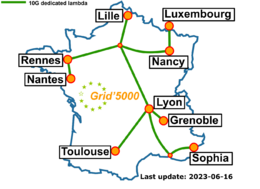Grid5000:Home
|
Grid'5000 is a precursor infrastructure of SLICES-RI, Scientific Large Scale Infrastructure for Computing/Communication Experimental Studies.
|
|
Grid'5000 is a large-scale and flexible testbed for experiment-driven research in all areas of computer science, with a focus on parallel and distributed computing, including Cloud, HPC, Big Data and AI. Key features:
Older documents:
|
Random pick of publications
Five random publications that benefited from Grid'5000 (at least 2925 overall):
- Jan Aalmoes. Intelligence artificielle pour des services moraux : Concilier équité et confidentialité. Intelligence artificielle cs.AI. INSA de Lyon, 2024. Français. NNT : 2024ISAL0126. tel-05014177 view on HAL pdf
- Adrien Schoen, Gregory Blanc, Pierre-François Gimenez, Yufei Han, Frédéric Majorczyk, et al.. A tale of two methods: unveiling the limitations of GAN and the rise of bayesian networks for synthetic network traffic generation. 2024 IEEE European Symposium on Security and Privacy Workshops (EuroS&PW), Jul 2024, Vienna, Austria. pp.273-286, 10.1109/EuroSPW61312.2024.00036. hal-04871298 view on HAL pdf
- Dorian Goepp, Samuel Brun, Quentin Guilloteau, Olivier Richard. Un prototype de cache de métadonnées pour le passage à l'échelle de NixOS-Compose. COMPAS 2024 - Conférence francophone d'informatique en Parallélisme, Architecture et Système, Jul 2024, Nantes, France. pp.1-8. hal-04632952 view on HAL pdf
- Thomas Firmin, Pierre Boulet, El-Ghazali Talbi. Asynchronous Multi-fidelity Hyperparameter Optimization Of Spiking Neural Networks. International Conference on Neuromorphic Systems (ICONS 2024), Jul 2024, Washington, United States. hal-04781629 view on HAL pdf
- Chanattan Sok, Laurent d'Orazio, Reyyan Tekin, Dimitri Tombroff. WebAssembly serverless join: A Study of its Application. International Conference on Scientific and Statistical Database Management (SSDBM), Jul 2024, Rennes France, France. pp.1-4, 10.1145/3676288.3676305. hal-04722875 view on HAL pdf
Latest news
![]() Cluster "clervaux" is now in the default queue in Luxembourg
Cluster "clervaux" is now in the default queue in Luxembourg
We are pleased to announce that the clervaux[1] cluster of Luxembourg is now available in the default queue.
Clervaux is a cluster composed of 48 CPU nodes.
Each node features:
This cluster was funded by the University of Luxembourg.
[1] https://www.grid5000.fr/w/Luxembourg:Hardware#clervaux
-- Grid'5000 Team 10:50, 21 October 2025 (CEST)
![]() Tutorials of the SLICES-FR school 2025
Tutorials of the SLICES-FR school 2025
The tutorial of the first SLICES-FR School, which was held from July 7th to 11th in Lyon are available on the following pages:
-- Grid'5000 Team 15:19, 1 October 2025 (CEST)
![]() End of support for Debian10 environments
End of support for Debian10 environments
Support for the debian10/buster kadeploy environments is stopped due to the end of upstream support and compatibility issues with recent hardware.
The last version of the debian10 environments (version 2025082716) will remain available on /grid5000. Older versions can still be accessed in the archive directory (see /grid5000/README.unmaintained-envs for more information).
-- Grid'5000 Team 09:21, 1 October 2025 (CEST)
![]() Cluster "chuc" is now in the default queue in Lille
Cluster "chuc" is now in the default queue in Lille
We are pleased to announce that the Chuc[1] cluster of Lille is now available in the default queue.
Chuc is a cluster composed of 8 nodes Apollo 6500 Gen10 Plus.
Each node features:
Due to a wattmeter hardware error, the cluster's energy consumption cannot be monitored via wattmeters yet.
You will be informed when the physical energy monitoring is available on this cluster.
This cluster was funded by the CornelIA CPER project.
[1] https://www.grid5000.fr/w/Lille:Hardware#chuc
Best regards,
Grid'5000 Technical Team
-- Grid'5000 Team 09:51, 15 September 2025 (CEST)
Grid'5000 sites
Current funding
INRIA |
CNRS |
UniversitiesIMT Atlantique |
Regional councilsAquitaine |



